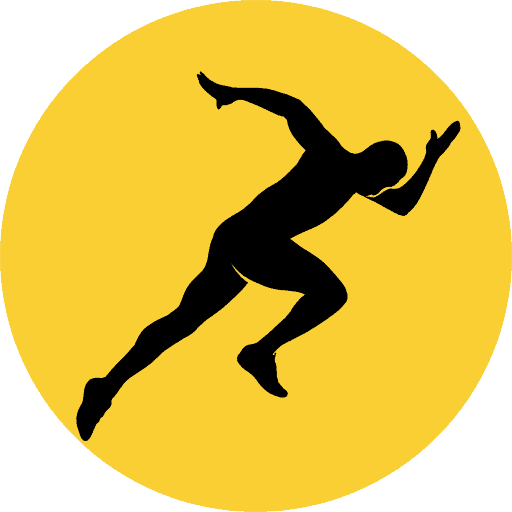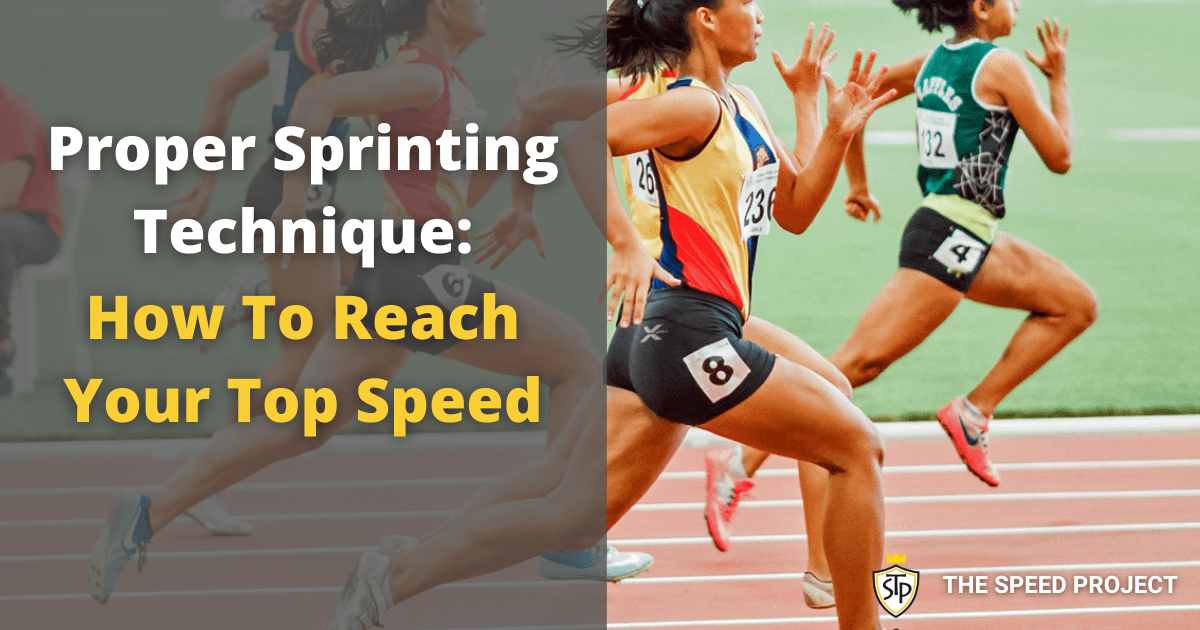Speed can be taught. All athletes have the potential to develop their speed. Working on your sprinting technique is a big part of the puzzle.
A proper sprinting technique not only allows you to run faster but also reduces the injury risk from poor sprinting mechanics.
The genetic makeup of an athlete may bless them with natural speed, but if efforts are not made to improve technique, they will never reach their full potential.
This article will focus on horizontal sprinting across 100m. But it will also provide a good basis of information that can be applied across all forms of sprinting.
Accelerative Sprinting
Whilst accelerating, force production is needed to generate speed when the foot makes contact with the ground. The greater the force you apply into the ground, the greater the return of impulse production, which increases speed.
Longer foot-to-ground contact times will allow for greater force generation and impulse production.
However, to cover ground more quickly it is important to limit the amount of time that your foot spends in contact with the ground during each stride.
Therefore the key is to apply the optimal amount of force possible into the ground during the limited amount of time that contact is made.
During acceleration, we must consider the point of foot-to-ground contact in relation to our centre of mass. To keep ground contact time as minimal as possible, the point contact should be behind your centre of mass.
This is why it’s important to drive low out the blocks (as shown in the video above), rather than immediately transferring into a vertical position.
Note: Take care not to overextend your stride. You will not be able to produce as much force during ground contact and the hamstring muscles will be more susceptible to injury.
Maximum Velocity Sprinting
As with acceleration, shorter ground contact times are linked with greater speed during maximum velocity.
Note: Maximum velocity can only be maintained for a short period of time. Eventually, you will begin to decelerate. Therefore it is vital to maintain sprinting form.
Applying optimal vertical forces during ground contact generates a force impulse great enough to overcome gravity more rapidly. This, along with maintaining good form allows the top sprinters to increase their stride frequency without decreasing stride length.
We stated that whilst accelerating, it is beneficial to have the foot behind your centre of mass. During maximum velocity sprinting this is only beneficial to a certain point. After which it will become detrimental to your stride cycle and increase deceleration by causing the upper body to lean forward.
Tip: Record yourself sprinting. Then you can look back at the video to make sure that your foot is placed under the hip when it makes contact with the ground.
The Stride Cycle
Touchdown ⇨ Toe off ⇨ Flight ⇨ Touchdown
⇦ (one complete stride cycle) ⇦
The stride cycle begins at the touchdown phase. At the point of touchdown, you lose momentum and slow down due to the braking effect.
This is where the foot makes its initial contact with the ground. It’s here that the ground contact time that we have been discussing begins. It ends after the toe off phase, where force is produced whilst pushing off the running surface.
This leads to the flight phase where neither foot is in contact with the ground and ends with the second touchdown as the rear leg becomes the lead leg.
Factors That Affect Sprinting Technique
Relaxation
Exaggerated tensing of the body whilst sprinting might feel like you are working harder and therefore running faster but this is a big red flag. Over-tensing often happens when an athlete is trying too hard to generate force and exert power.
Over-tensing causes the body to waste energy and become stiff. If the body is unable to move fluently, your form will be poor and you’ll begin to decelerate more rapidly.
You want to stay as relaxed as possible and maintain a smooth running technique.
Posture
Good posture is essential for sprinting!
Many athletes have a tendency to lean forward by over-flexing at the hips. A slight tilt is recommended, but leaning too far forward will slow you down and negatively affect your sprinting mechanics.
Performing sprint technique drills with strict form is a great way to improve your posture whilst sprinting. Poor form during technique drills will transfer into your sprinting technique. Therefore, it’s highly important that they are performed correctly.
Simple Way To Improve Your Posture And Strength
A great exercise that I get my athletes to perform is back extensions. Performing this exercise regularly increases trunk strength and generally improves physical fitness.
Back extensions target your erector spinae which contains parallel sets of muscles that run down the spine from the base of the neck to the sacrum.
These muscles control extension and flexion of the vertebral column and can increase optimal posture of the spine whilst sprinting
Back extensions engage the hamstrings and also strengthen other muscles. This helps improve overall core strength and keeps the torso erect when sprinting.
Arm Movement
Your arms play a vital role when sprinting. The arms help to propel the legs, which will lead to faster sprinting.
Sprinting legend Carl Lewis once said he uses the cue “elbow to the sky, thumb to the eye” to ensure his athletes are moving their arms correctly. I like this a lot. It’s catchy and easy for my athletes to remember.
As mentioned, for fluidity, it’s important to stay relaxed. Relaxation in the arms comes from dropped shoulders and no tension in the hands or fists. This will help you achieve a synchronised rhythm with your legs.
Stride Length
Be careful when opening up your stride when trying to increase the length of ground covered.
Over-striding means that you will generate less power during ground contact. This will increase the rate at which you decelerate.
It also puts a lot of strain on the hamstring muscles, increasing your risk of injury.
Try to complete every sprint cycle in a circular motion. You are aiming to keep your knees parallel with the ground, and your feet dorsiflexed towards your shins.
Sprint Starts
Perfecting your sprint starts (especially when using blocks) is arguably the most important aspect of the acceleration phase. It will affect your overall efficiency throughout the race.
It’s helpful to practice your starts separately so that you are comfortable using blocks, moving efficiently and reacting to the gun.
Sprinting Technique Checklist And Reminders
Upper body:
Head
- Keep your head in line with your spine.
- Focus your sight directly down the track.
- Relax your neck and jaw muscles.
- Don’t clench your teeth.
Shoulders
- Don’t shrug your shoulders. They should be kept low, not up by your ears.
Hands and arms
- Run with an open palm (if you naturally run with a closed fist, stay relaxed and don’t clench).
- Remember “Elbow to the sky, thumb to the eye.”
- Sync arms with legs.
Torso
- Remain upright during maximum velocity. Flexing or extending at the hip will limit your range of motion.
Lower body:
- Run on the balls of your feet and push off with your toes.
- Keep your stride long but comfortable. Over-striding means less power and unnecessary stress on the hamstrings.
- Focus on the rapid turnover of sprint cycles with knees parallel to the ground.

